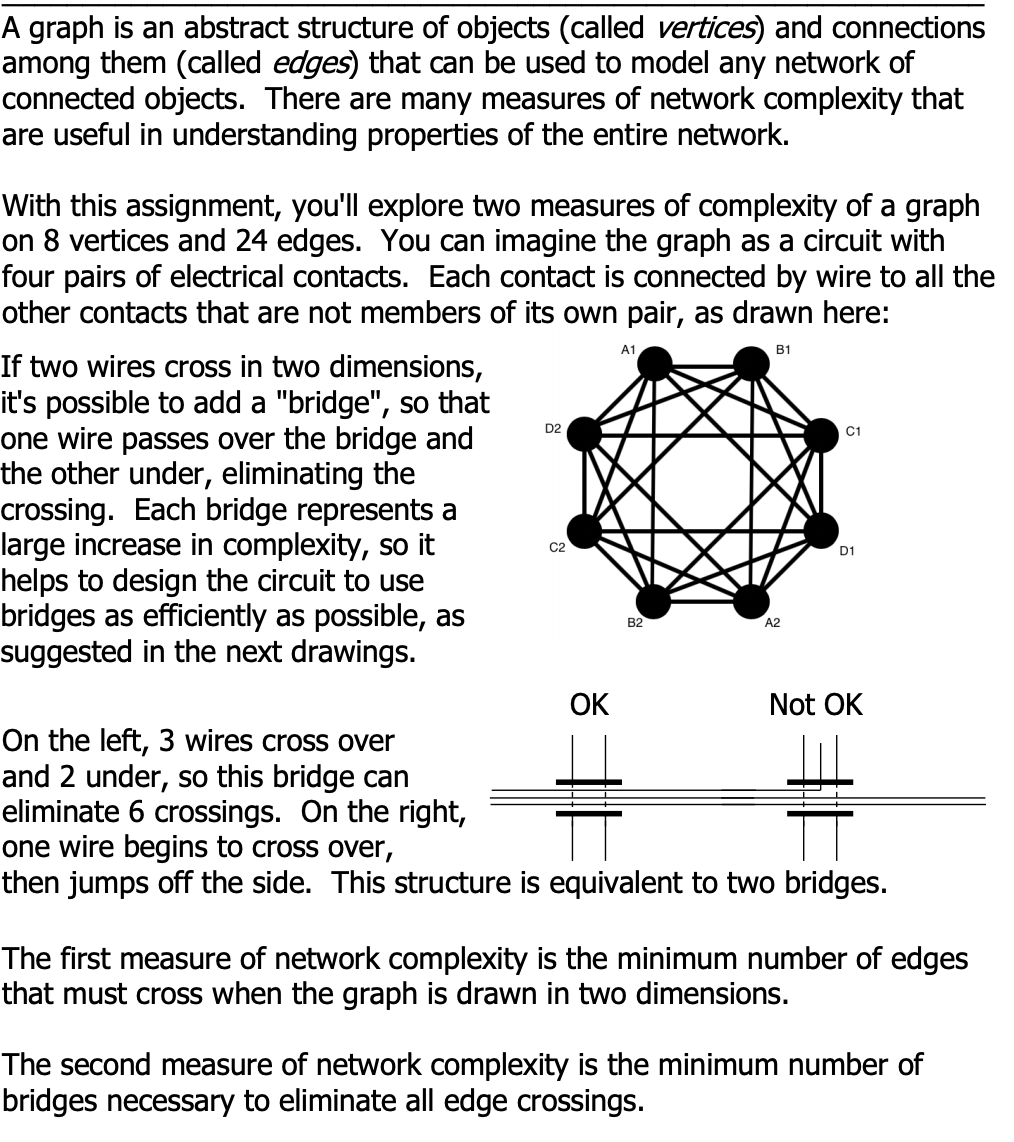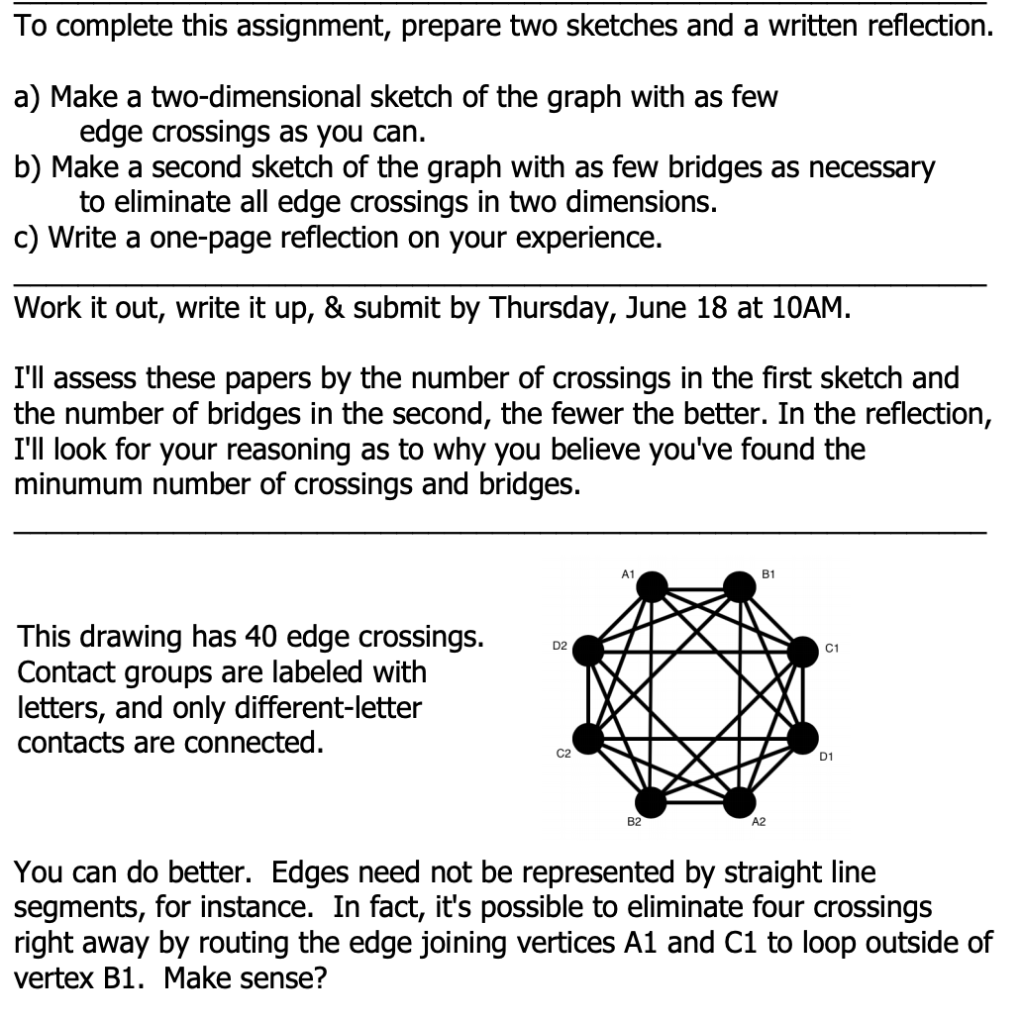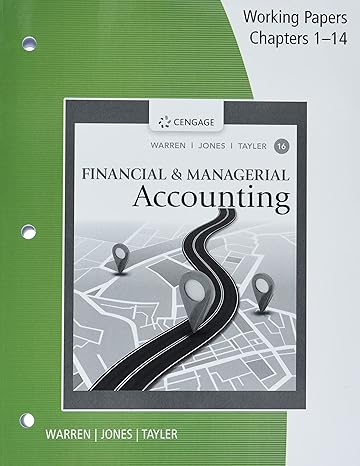Need help with A, B, and C of this DISCRETE MATH assignment

A graph is an abstract structure of objects (called vertices) and connections among them (called edges) that can be used to model any network of connected objects. There are many measures of network complexity that are useful in understanding properties of the entire network. A1 B1 D2 C1 With this assignment, you'll explore two measures of complexity of a graph on 8 vertices and 24 edges. You can imagine the graph as a circuit with four pairs of electrical contacts. Each contact is connected by wire to all the other contacts that are not members of its own pair, as drawn here: If two wires cross in two dimensions, it's possible to add a "bridge", so that one wire passes over the bridge and the other under, eliminating the crossing. Each bridge represents a large increase in complexity, so it helps to design the circuit to use bridges as efficiently as possible, as suggested in the next drawings. OK Not OK On the left, 3 wires cross over and 2 under, so this bridge can eliminate 6 crossings. On the right, one wire begins to cross over, then jumps off the side. This structure is equivalent to two bridges. D1 B2 A2 The first measure of network complexity is the minimum number of edges that must cross when the graph is drawn in two dimensions. The second measure of network complexity is the minimum number of bridges necessary to eliminate all edge crossings. To complete this assignment, prepare two sketches and a written reflection. a) Make a two-dimensional sketch of the graph with as few edge crossings as you can. b) Make a second sketch of the graph with as few bridges as necessary to eliminate all edge crossings in two dimensions. c) Write a one-page reflection on your experience. Work it out, write it up, & submit by Thursday, June 18 at 10AM. I'll assess these papers by the number of crossings in the first sketch and the number of bridges in the second, the fewer the better. In the reflection, I'll look for your reasoning as to why you believe you've found the minumum number of crossings and bridges. A1 B1 D2 C1 This drawing has 40 edge crossings. Contact groups are labeled with letters, and only different-letter contacts are connected. D1 B2 You can do better. Edges need not be represented by straight line segments, for instance. In fact, it's possible to eliminate four crossings right away by routing the edge joining vertices A1 and C1 to loop outside of vertex B1. Make sense? A graph is an abstract structure of objects (called vertices) and connections among them (called edges) that can be used to model any network of connected objects. There are many measures of network complexity that are useful in understanding properties of the entire network. A1 B1 D2 C1 With this assignment, you'll explore two measures of complexity of a graph on 8 vertices and 24 edges. You can imagine the graph as a circuit with four pairs of electrical contacts. Each contact is connected by wire to all the other contacts that are not members of its own pair, as drawn here: If two wires cross in two dimensions, it's possible to add a "bridge", so that one wire passes over the bridge and the other under, eliminating the crossing. Each bridge represents a large increase in complexity, so it helps to design the circuit to use bridges as efficiently as possible, as suggested in the next drawings. OK Not OK On the left, 3 wires cross over and 2 under, so this bridge can eliminate 6 crossings. On the right, one wire begins to cross over, then jumps off the side. This structure is equivalent to two bridges. D1 B2 A2 The first measure of network complexity is the minimum number of edges that must cross when the graph is drawn in two dimensions. The second measure of network complexity is the minimum number of bridges necessary to eliminate all edge crossings. To complete this assignment, prepare two sketches and a written reflection. a) Make a two-dimensional sketch of the graph with as few edge crossings as you can. b) Make a second sketch of the graph with as few bridges as necessary to eliminate all edge crossings in two dimensions. c) Write a one-page reflection on your experience. Work it out, write it up, & submit by Thursday, June 18 at 10AM. I'll assess these papers by the number of crossings in the first sketch and the number of bridges in the second, the fewer the better. In the reflection, I'll look for your reasoning as to why you believe you've found the minumum number of crossings and bridges. A1 B1 D2 C1 This drawing has 40 edge crossings. Contact groups are labeled with letters, and only different-letter contacts are connected. D1 B2 You can do better. Edges need not be represented by straight line segments, for instance. In fact, it's possible to eliminate four crossings right away by routing the edge joining vertices A1 and C1 to loop outside of vertex B1. Make sense








